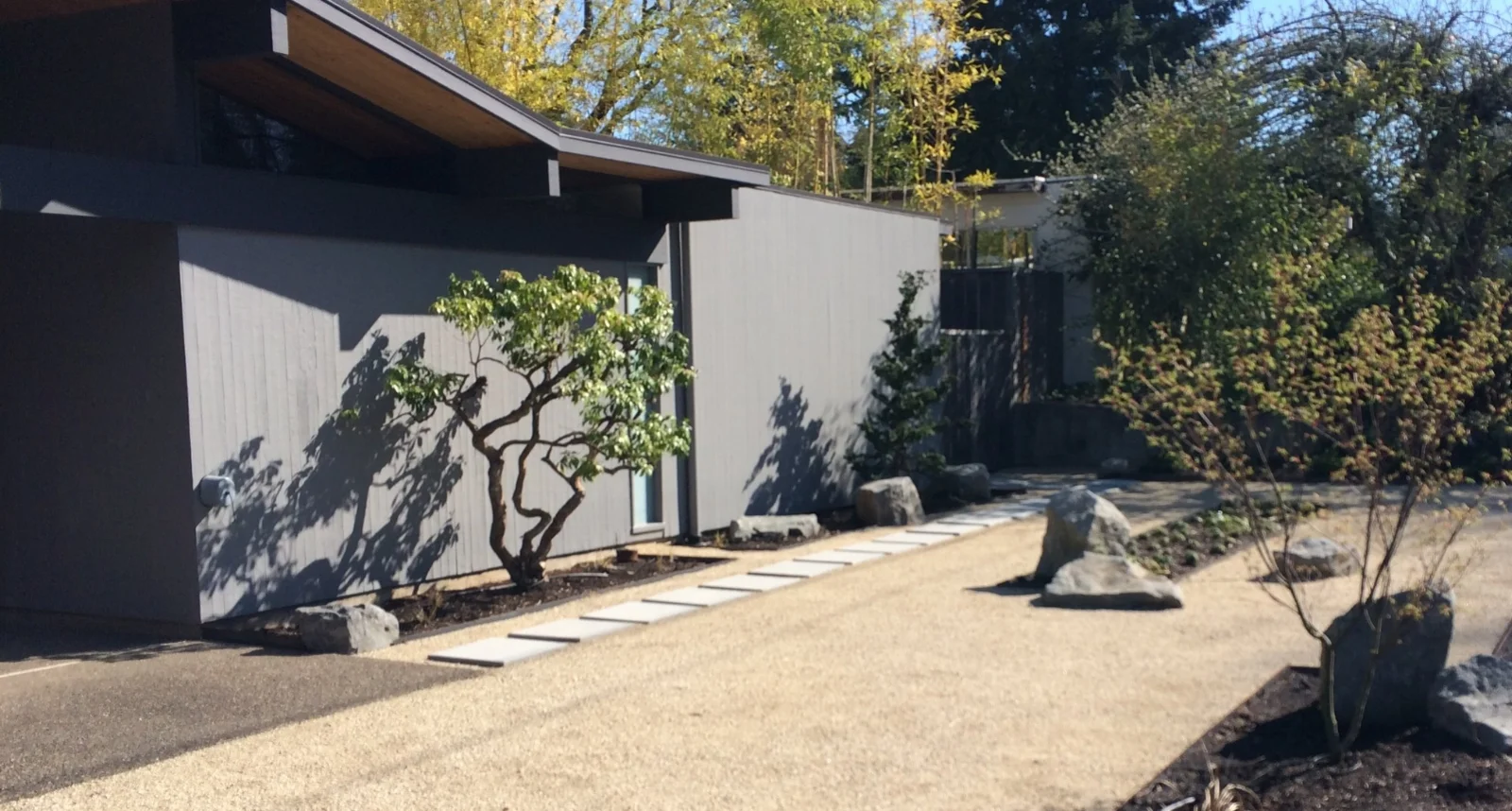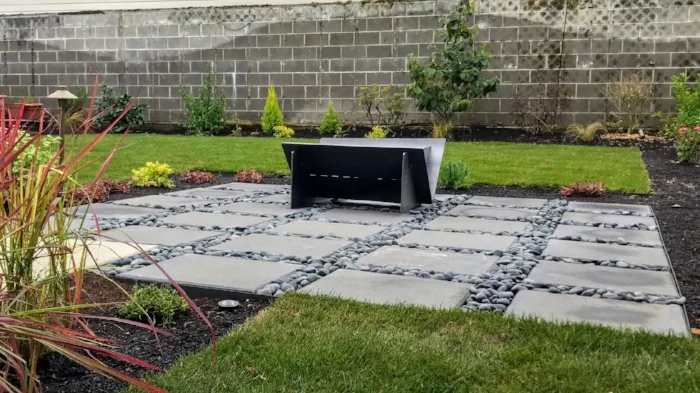MODERN landscapes. (Capitalizing the first word is very modern.)
If I asked you to send me a picture of a modern garden, what would you send? Probably something like this:
Right?
Now that's a great modern front yard. At least I think it is (we designed and installed it!) But a "modern" garden can be so many different things. It is not simply straight lines. Minimalism is not a prerequisite. Decomposed granite, concrete, corten steel and mass plantings of grasses are not required.
So then, what is a modern landscape design?
Modern landscaping is a combination of elements, techniques, materials, and approaches. Not all of these will be present in every modern outdoor space, but a truly contemporary yard will utilize many of them. Check out my list below to get a better understanding of what the modern landscape can be.
23 Characteristics of a Modern Garden:
Modern fire pit patio.
Structure imposed by hardscape. Spaces are shaped and defined by paths and patios, the portions of the landscape that humans use. This is where the design process starts, with the layout and configuration of practical spaces.
Hardscape materials are mixed and matched. Concrete, natural stone, pebbles, decomposed granite, and more may be used in the same space. Mixing materials allows a space to have a high hardscape-to-softscape ratio without feeling cold. Modern gravel gardens illustrate how important the texture of hardscape is!
Water is kept on site. Using pavers, stone, and concrete can cause drainage issues and send rain water flowing into sewer systems. Modern landscapes utilize rain gardens, dry wells, swales, etc to capture water and hold it until it can naturally soak into the ground.
Watering systems are smart. An irrigation system, designed properly, will use less water to keep your plants happy than a hose end sprinkler. Modern irrigation systems use sub-surface drip, high efficiency nozzles, and smart timers to ensure no water is wasted.
Water features are smart. A carefully designed and constructed water feature will use less water than an area of lawn the same size. Modern water features won't leak, and utilize high efficiency pumps to move a bunch of water with very little electricity. It should also look attractive when it's not running.
Lighting is low voltage and LED (smart). LED bulbs are efficient and last forever. Stop using anything else. A high quality metal fixture that will patina attractively will look good for many years to come.
No visible plastic. Edging for paths and patios is 1/8" steel. Planters are corten steel, concrete, or stone. Fences are wood. Any plastics are purely functional and out of site.
Wood is important. It acts as a contrasting element when integrated with concrete or stone. As a walkway it can indicate a transition to a more natural portion of the garden. In contemporary gardens with a Japanese influence wood can introduce Wabi-sabi as it ages naturally.
Lawn is reduced or eliminated. A traditional landscape has the always green and lush lawn as it's centerpiece. The modern landscape designer understands that lawn can have a place, but it's too demanding of time and resources to be larger than absolutely necessary.
Maintenance requirements are low to moderate. Many (not all) modern outdoor spaces have an abundance of hardscape and a lower amount of lawn and plants. The amount of time spent weeding, pruning, and raking is reduced as a result.
Water use is lower. See points 3, 4, 5, and 9.
Trees are functional. Trees are not chosen or placed simply because we like them. Trees are used to create ceilings for outdoor spaces (see #1 here). They are a tool for controlling the scale of a garden. Deciduous trees benefit our indoor spaces by providing summer shade and winter light. Conifers of all sizes become punctuation marks and focal points year-round.
Shrubs have structure that is easy to maintain. Shrubs that naturally have a strong structure are utilized. Some may layer (pieris or azaleas ). Others are upright (sky pencil holly or nandina) or mounded (mugo pine). Small shrubs with tidy habits (hebe) are perfect for the small urban garden.
Grasses serve many purposes. Ornamental grasses are the "duct tape" of the modern garden. They soften hard edges, brighten up dark corners, screen, fill in gaps between slabs of hardscape, and transition the eye from patio to water feature to gravel garden to lawn. Japanese forest grass, feather reed grass, and dwarf mondo grass are common choices.
Plants are native, when that's the best choice. The modern family wants plants that are hardy, drought tolerant, friendly to wildlife and pollinators. In many cases that means natives are the best choice.
Plants are grouped carefully. Maintenance can be lowered planting multiples of a variety together. It allows you to care for plants as an area, not a bunch of individuals. "Mass plantings" can take this concept beyond 3-4 plants to dozens or even hundreds. Plants may also be grouped by water use so that a drought tolerant plant is not over watered due to being next to your hydrangea.
Ground cover is.... walkable, drought tolerant, and looks good year-round. It out competes weeds and keeps slopes in their places. It fills in gaps in stepping stones and slabs.
More resources are dedicated to the backyard landscape. Many people only see their front yard as they drive in and out of the garage. So the front yard is for the neighbors while the back yard is for you. Design the back first, then echo some of its elements in the front, in a way that works for the space and your budget.
The outside is connected to the inside. Outdoor living spaces should flow easily from inside spaces. Walking in and out should be as comfortable and easy as possible. This may mean that we rework steps, landings, decks, etc.
You should feel close to your outside space... even if you spend all winter inside. The views out your primary windows are important. Plantings near those windows have to do more than just provide privacy. Who wants to spend all winter looking at the inside of a hedge?
Play spaces are integrated into the landscape. The garden is meant to be used, so areas for play are not hidden in a corner of the yard. By integrating playable spaces into the landscape your whole family can enjoy the garden together. This approach also means you won't have to renovate a portion of the garden once your kids are older.
Flexibility is prized in the urban yard. When available space is limited we try to avoid assigning just one use to an area. This means you might get a modular fire pit, rather than a built in one.
Material choices are secondary to structure. It's not using corten steel or ipe decking that makes a space contemporary. Material options change over time, with some falling our of favor while others become popular. A modern garden is not a result of obsessing over the material choices, but of getting the structure of the garden correct!
No wasted space in this contemporary garden.
While this list is not exhaustive, and will certainly change over time, it should make clear that modern landscape design is more than just a style or even an aesthetic.
In fact, a contemporary garden can be any number of styles. A sprawling lush green space overflowing with blooms can be modern. The urban backyard garden with a chicken coop is modern too.
Whatever your personal style, a modern garden can be designed to fit it. Need some help with that? Contact Portland's modern landscape design specialists, Ross NW Watergardens for a free consultation!
Looking for modern planters, fire pits, or arbors? Here is a list of great modern garden accessories.


